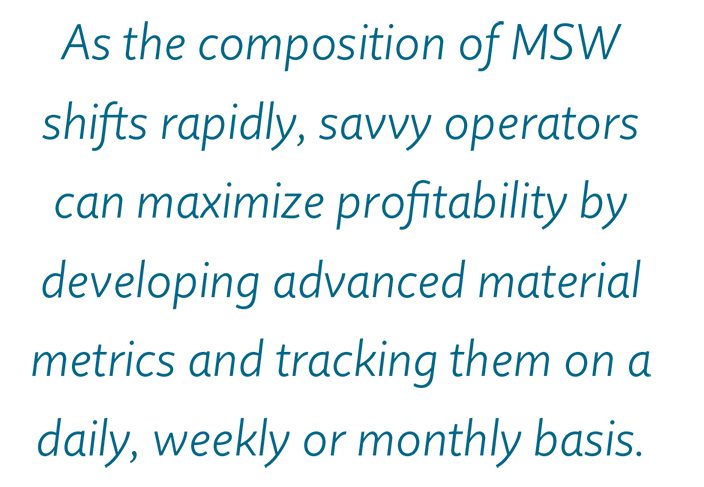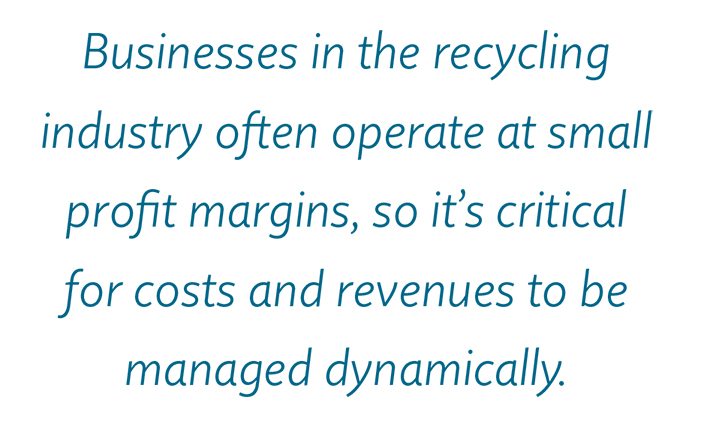This story originally appeared in the March 2017 issue of Resource Recycling.
Subscribe today for access to all print content.

Business growth at a materials recovery facility or other recycling operation requires a deep understanding of the unique circumstances surrounding the material being handled.
An operator will of course want to know tonnages of different plastic resins, paper grades and other recyclables. And to understand the larger business opportunities and challenges, management will look at critical numbers such as commodity values, contamination rates, landfill tip fees, equipment costs and much more.
Knowing the data to keep track of – and actually compiling the numbers – is a great start. But the truly transcendent task is to then organize and act on the information. It’s at this level that companies can separate themselves from competitors and make smart decisions to catalyze business growth, even as the industry as a whole goes through significant shifts or downturns.
How to start making sure data is being optimized? The key is knowing where to look and then finding systems to organize numbers properly.
Responding to realities in materials stream
A handful of common trends are affecting profitability at recycling companies around the country. And data insights can help in many of these instances.
Some challenges are waste stream focused. For example, the changing composition of municipal solid waste (MSW) has caused a mismatch between existing processing capabilities and what is currently required. As reported by Waste Management in 2014, over the last two decades the paper content in MSW has steadily declined (by as much as 50 percent) while plastics content is increasing, currently accounting for around 13 percent of total MSW quantity. This is a concern because most large processing facilities were built with the understanding fiber would make up a majority of the stream.
Another waste stream-related issue is increasing levels of contamination, which leaves recyclers with unpredictable quality of outputs.
There are a number of ways operators can use optimized information to effectively respond to such struggles in the stream. When the percentage by weight of high-value materials in the incoming loads diminishes, the revenue per ton from the output decreases. This means that the MRF operator has to look for other ways to stay profitable – either by increasing the rate charged for inbound materials, reducing operation costs, increasing throughput, or employing a combination of these strategies.
Data analysis can help make the decision easier.
Most MRFs have scale systems that generate a ticket for each load of material that is brought into the facility. This ticket captures a lot of detailed data: date, time, customer, source location, material, weight and unit price charged (price per ton). Depending on the size of the operation, this could result in thousands of transactions generated on a daily basis.
This raw data is not suitable for recognizing any trends in the material mix (composition) or prices charged for the materials. But by using a software system, the operator can begin to develop statistics such as the average unit price per ton by material category, and the operator can also see how that number changes on a daily, weekly or monthly basis.
 This basic level of visibility is the gateway to a lot of insights that will help in making both short- and long-term decisions. Without it, the operator is running blind and is missing the opportunity to see exactly how material composition is evolving in the specific market the facility serves.
This basic level of visibility is the gateway to a lot of insights that will help in making both short- and long-term decisions. Without it, the operator is running blind and is missing the opportunity to see exactly how material composition is evolving in the specific market the facility serves.
Data help in volatile markets
In addition to waste stream challenges, recyclers also face volatility of prices for their output products. Though markets have rebounded a bit of late, the fluctuating commodity prices in the last two years were the biggest factors causing financial challenges in the recycling industry. Profits were ultimately eroded due to a lack of harmonization between internal costs and external prices.
For instance, over the 12 months in 2016, prices of some grades of recovered plastics decreased by 30 to 40 percent. Facilities relying on those resins of course needed to understand what such a price shift would mean to the bottom line and be able to act accordingly.
An additional challenge here is clearly showing how the output of a facility is tied to the commodities that are exchanged in the marketplace. To start with, there are scant industry standards for material specifications of MRFs and other recyclers. Currently, contamination thresholds for inbound loads and quality specifications for outbound materials are largely based on mutually agreed upon contracts between suppliers and processors. There is also the issue of bringing the commodity price information and the calculated costs of the output materials together so that pricing decisions can reflect these on a time-wise basis.
To help out in this area, operators would be wise to establish a system that uses both target and transaction level pricing.
When engaged in target pricing, recycling facilities typically publish prices (or rates) monthly or quarterly for the materials that are delivered to or picked up by them. These inbound prices are usually published or set in accordance with contracts between the MRF and each of its suppliers. These prices are established such that they are both profitable and competitive for the MRF.
 In order to achieve a certain target profit margin, the MRF manager would have to calculate the prices of inbound materials (the target price) so that the target profit margin is achieved after accounting for the processing costs, the cost of waste disposal and the revenue from the output products. The price should then be assessed for its competitiveness relative to the area where the MRF or recycling facility is located.
In order to achieve a certain target profit margin, the MRF manager would have to calculate the prices of inbound materials (the target price) so that the target profit margin is achieved after accounting for the processing costs, the cost of waste disposal and the revenue from the output products. The price should then be assessed for its competitiveness relative to the area where the MRF or recycling facility is located.
Once target prices (or rates) are established, the MRF manager typically uses these prices as guidance in actual pricing for a transaction. From transaction to transaction, the price may differ from the target price for many reasons. The specific load of materials could have a different quality level than what was assumed for the target price, or the market price for a commodity may have unexpectedly changed.
For these reasons, the MRF manager or recycler may price each individual transaction separately. But in order to do so, the decision-maker would have to know the various costs for each transaction so that they can be priced to be profitable. The ability to set the pricing for a transaction provides enormous flexibility to the decision-maker in achieving the financial goals while also rewarding loyalty of long-term customers.
To spend or not to spend?
A final area where advanced data analysis can significantly lift recycling operations is equipment purchasing. While a boon when investments pay off, the procurement of new technologies can be overwhelming for many recyclers. This is especially true when it comes to assessing the true costs and benefits of machinery and other investments.
An interesting example of this can be seen in decisions related to material sorting. In 2014, the plastics recycling consultancy Moore Recycling Associates and The Association of Plastic Recyclers released a tool called the Sort for Value Matrix. The matrix demonstrated that plastics recycling revenues could grow from $160 to $308 per ton when additional sorting was performed to generate specific material grades.
That data analysis showed the possibilities of sorting. But it was then up to operators to determine whether expenditures in new equipment, revamped processing lines and extra staff could be offset by the higher prices garnered for material at the end of the process.
Key data points to be collected in this realm include the capital expenditures (CapEx) for the new process or technology, operational expenditures (OpEx) involved in implementing it, the improvement in quality of the output, the price of commodities in the marketplace and the future trends and projected volumes of materials to be processed.
Managers might also use a process called CapEx justification. The goal here is to estimate the costs and benefits of an investment that requires a significant capital outlay. While this is a well-established process in many organizations, the quality of the process is dependent upon the extent and quality of the data. Care must be taken when obtaining the data on capital costs, operational costs, materials volumes forecasts, commodity price forecasts, and estimated improvements on quality of the output. Information on these variables will likely vary as time goes on – in other words, the uncertainty in these forecasts will affect the quality of the cost benefit analysis. Creating scenarios with probabilities and then evaluating the costs and benefits for these scenarios is a powerful way of accounting for uncertainties.
The key to a thriving industry
Businesses in the recycling industry often operate at small profit margins. Hence, it is critical for the costs and revenues to be managed dynamically, particularly with shifting commodity markets and constantly evolving waste streams.
Fortunately, the information technology and software solutions available today are up to the challenge of providing decision-makers with timely information and accurately calculated costs. The price of these solutions has become increasingly affordable with cloud computing and software-as-a-service offerings in which there is no need to own software outright.
Ultimately, mastering data enables an operation to master efficiency. In an era when pressure is on the entire recycling chain to lift recycling rates and handle a greater variety of materials, optimizing efficiency in facilities should be a top concern. It may be the difference between a thriving recycling system and one that stagnates.
Ramesh Srinivasan is the founder and CEO of Eco-Catalyst Inc. and can be reached at [email protected].

